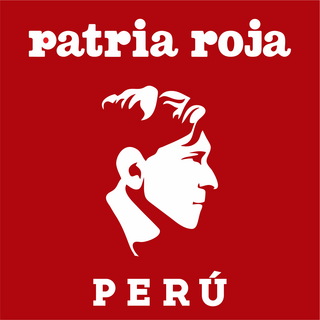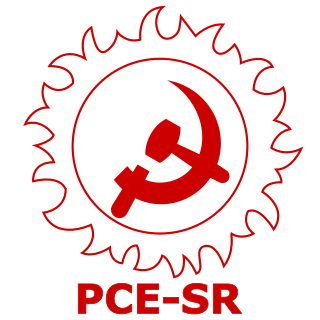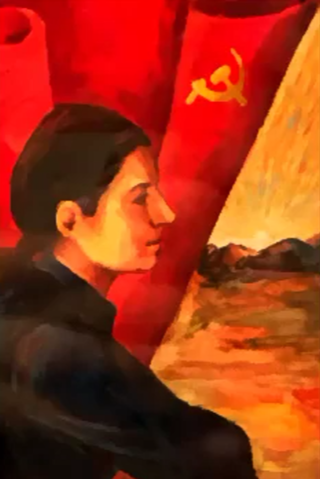The politics of the Republic of Peru takes place in a framework of a unitary semi-presidential representative democratic republic, whereby the President of Peru is both head of state and head of government, and of a pluriform multi-party system. Executive power is exercised by the President and the Government. Legislative power is vested in both the Government and the Congress. The Judiciary is independent of the executive and the legislature. The Economist Intelligence Unit rated Peru a "hybrid regime" in 2022.

The Shining Path, self-named the Communist Party of Peru, is a far-left political party and guerrilla group in Peru, following Marxism–Leninism–Maoism and Gonzalo Thought. Academics often refer to the group as the Communist Party of Peru – Shining Path to distinguish it from other communist parties in Peru.

The Workers' Commissions since the 1970s has become the largest trade union in Spain. It has more than one million members, and is the most successful union in labor elections, competing with the Unión General de Trabajadores (UGT), which is historically affiliated with the Spanish Socialist Workers' Party (PSOE), and with the anarcho-syndicalist Confederación General del Trabajo (CGT), which is usually a distant third.
Communism in Peru was represented by far-left-oriented organizations that refer to themselves as communist (comunista) parties, movements, organizations, groups, etc.

Manuel Rubén Abimael Guzmán Reynoso, also known by his nom de guerreChairman Gonzalo, was a Peruvian Maoist guerrilla leader. He founded the organization Communist Party of Peru – Shining Path (PCP-SL) in 1969 and led a rebellion against the Peruvian government until his capture by authorities on 12 September 1992. He was subsequently sentenced to life imprisonment for terrorism and treason.

The Peruvian Communist Party (Marxist–Leninist) is an anti-revisionist Marxist–Leninist communist party in Peru. It was founded in January 1964 following a split in the Peruvian Communist Party, and was originally known as the Peruvian Communist Party – Red Flag.

The Communist Party of Peru – Red Fatherland is a far-left, communist political party in Peru. It was founded in 1970, through a split in the Peruvian Communist Party – Red Flag. It is led by Alberto Moreno and Rolando Breña. Its youth wing is the Communist Youth of Peru.
Union of Iranian Communists (Sarbedaran) (UIC(S); also non-officially translated by others as the League of Iranian Communists; Persian: اتحادیه کمونیستهای ایران, romanized: ʾEtteḥādiye-ye Komūnīst-hāy-e ʾErān, lit. 'Union of the Communists of Iran'), simply known by its former armed branch's name Sarbedaran (Persian: سربداران, romanized: Sar-be-Dār-ān, lit. 'the head-on-gallow mass') was a Maoist organization in Iran. The UIC(S) was formed in 1976 after the alliance of a number of Maoist groups carrying out military actions within Iran. The group prepared an insurrection starting in 1981, but it was dismantled by 1982.

The internal conflict in Peru is an armed conflict between the Government of Peru and the Maoist guerrilla group Shining Path. The conflict's main phase began on 17 May 1980 and ended in December 2000. From 1982 to 1997 the Túpac Amaru Revolutionary Movement waged its own insurgency as a Marxist–Leninist rival to the Shining Path. As fighting intensified in the 1980s, the Peruvian government had one of the worst human rights records in the Western Hemisphere; Peru experienced the most forced disappearances in the world during the period while the Peruvian Armed Forces acted with impunity throughout the conflict, sometimes massacring entire villages.

The Communist Party of Ecuador – Red Sun, also known as Puka Inti is a Marxist–Leninist–Maoist political party and guerrilla group in Ecuador. It was founded on 1 June 1993. From inception, until their death, the group's former leader used the nom de guerre "Comrade Joselo". Joselo died on November 6, 2022 with no announcement of a successor. The PCE-SR consists mostly of former members of the underground leftist group ¡Alfaro Vive, Carajo! The organization follows the ideas of the Peruvian communist leader Abimael Guzmán, founder and longtime chairman of the Shining Path in Peru. The organization has also become close to Mantaro Red Base Committee, and the Communist Party of India (Maoist), and is also a member of the International Communist League (Maoist).
Chuschi District is one of six districts of the Cangallo Province in Peru. It is known for being the site of the first attack perpetrated by the maoist terrorist organization Shining Path, initiating the Peruvian conflict.

Augusta Deyanira La Torre Carrasco, also known as Comrade Norah, was a Peruvian communist, recognized as the number two in command of Shining Path. La Torre's influence on her husband, Shining Path founder Abimael Guzmán, is credited with establishing equality for women with regard to participation within the revolutionary organization, and during its militant actions.
The Revolutionary Communist Party (Working Class) (Spanish: Partido Comunista Revolucionario-Clase Obrera) was a Maoist communist political party in Peru in the 1970s. Founded as a split faction from Vanguardia Revolucionaria-Político Militar, it was led by Manuel Dammert Ego-Aguirre and Ernie de la Jara y Basombrío.
Marxism–Leninism–Maoism (MLM), also known as Marxism–Leninism–Mao Zedong Thought, is a political philosophy that synthesizes and builds upon Marxism–Leninism and Mao Zedong Thought. Marxism–Leninism–Maoism was first formalized by the Shining Path in 1982.
Pucaparina is a mountain in the Vilcanota mountain range in the Andes of Peru, about 4,800 metres (15,748 ft) high. It lies in the Puno Region, Melgar Province, Nuñoa District.
Pucachuaña is a mountain in the Vilcanota mountain range in the Andes of Peru, about 5,000 metres (16,404 ft) high. It is situated in the Puno Region, Melgar Province, Nuñoa District. It lies west of Yuracjasa.

Broad Left Front is a political coalition of leftist parties and movements in Peru.

The Militarized Communist Party of Peru is a political party and militant group in Peru that follows Marxism–Leninism–Maoism and participates in the communist insurgency in Peru. It is considered a terrorist organization by the government of Peru. The MPCP operates primarily in the VRAEM area and is involved in the area's coca production. Comrade José has been the leader of the MPCP since its official creation in 2018 after its final split from the declining Shining Path guerilla group.
Women in the Internal conflict in Peru were active in a large variety of roles, both making significant impacts on the Conflict and with the Conflict having significant impacts on them. Post-conflict women, especially Indigenous women, have played major roles in reconciliation efforts.

The Shining Path remnants are factions derived from the armed group that split off after the peace agreement between the imprisoned Abimael Guzmán and the Peruvian State in 1993. These include the Sendero Luminoso del Alto Huallaga (disbanded), the Mantaro Rojo Base Committee and the Militarized Communist Party of Peru.











